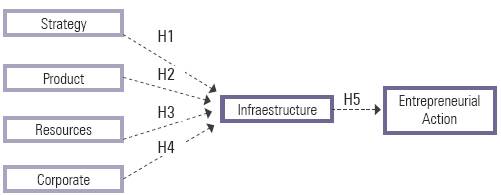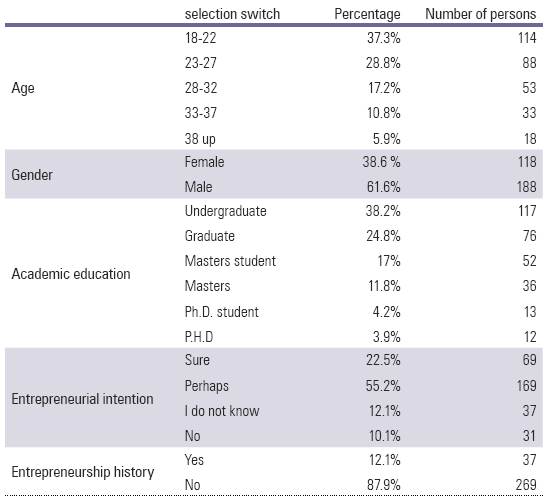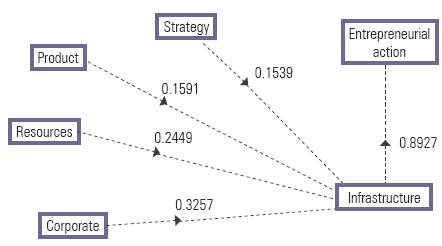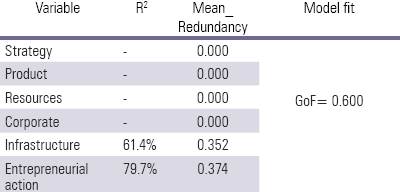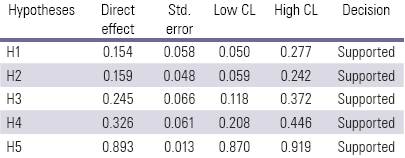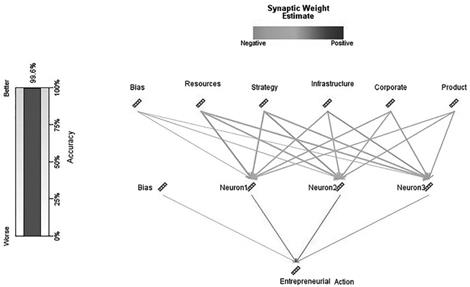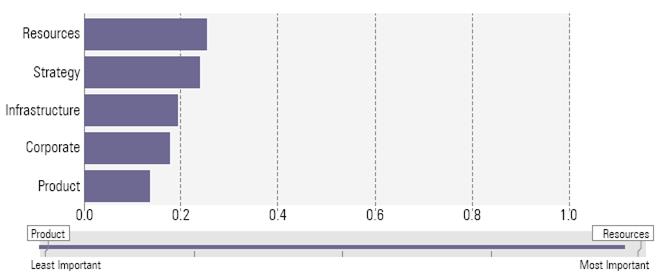INTRODUCTION
Entrepreneurship is important in the national and global economies today so that, it main engine of economic growth and prosperity (Boufaden, 2013; Dutta, Roy, & Sobel, 2009). Small and medium-sized enterprises (SMEs) in the European Union account for 99 % of the total employment (European Commission, 2016) and In the United States, small entrepreneurs have created employment between 2.5 million and 4.7 million each year from 1994 to 2015 (bls, 2016). Khajeheian (2014) the effective role of entrepreneurship in developing countries has attracted attention; Iran is one of these countries. In recent years, entrepreneurship has increased in Iran. World statistics show In 2018, Iran ranked 72 with an increase of 13 in the world’s 137 countries (Acs et al, 2018). Although the census points out that growth is in Iran but these show Iran’s unfavorable position, part of this is due to government policy. Accordingly, one of Iran’s researches identifies the gap between government-related entrepreneurship programs in Iran with global indicators of increasing levels of government-led entrepreneurship activities, such as reforming government policies and laws for the success of Iranian entrepreneurs (Modaresi & Davodi, 2015). Statistics showed In 2015 Of the nascent Iranian entrepreneurs who entered the entrepreneurial world in the last three years, 7 % reached the stage of stability; also 4 % went out of their businesses this year (IRNA, 2016) Therefore, it is felt that entrepreneurship in Iran needs a model But we don’t have this kind of model. This study seeks to provide a model for the success of media entrepreneurship in Iran. Media entrepreneurship is important because, in the era of knowledge economy, media industries can become the engine of economic development (Hollifield, 2003: 101). In this research, based on the framework Khajeheian (2013) the success factors of media entrepreneurs are modeled in an entrepreneurial way. We first identify the relationship between the variables by using our structural equations modeling, and then the accuracy of the proposed model is determined according to the mentioned framework, and the importance of the factors of this model, is determined. This research, on the one hand, has led to a strengthening of media entrepreneurship literature, whose weakness was emphasized by Khajehian (2017) and on the other hand, innovation is in the methodology.
LITERATURE ON MEDIA ENTREPRENEURSHIP
In 1971, the first research on entrepreneurship and media by looking at the field of music was published (Peterson & Berger, 1971) but until 2000, there are not many articles on the subject; however, the third millennium is a beginning of interest in research on entrepreneurship and media (Hang & Van Weezel, 2007). However, what is now clear is that entrepreneurship and media have a mutual impact on each other. (Hang & Van Weezel, 2007; Khajeheian, 2013; Khajeheian & Roshandel Arbatani, 2011). On one hand, the media can promote entrepreneurship and on the one hand, entrepreneurship phenomena heavily impact media industries as long as they, in their very nature, fall into the culture and creative industries (Hang & Van Weezel, 2007) however, our focus in this research is on the impact of entrepreneurship in the media industry, which is considered media entrepreneurship. Media entrepreneurship is still nascent. Achtenhagen (2008: 124) wrote: “As the area of media entrepreneurship is still a young and undeveloped field, this phenomenon is poorly understood” and now too some researchers still believe there is no significant improvement on media entrepreneurship (Khajeheian, 2017: 92). Of course media entrepreneurship is defined by some researchers. According to Hoag and Seo (2005: 3) media entrepreneurship is the creation and ownership of a small media company or media organization that creates at least one innovation in the business market. Khajeheian & Roshandel Arbatani (2011) the media entrepreneurship defines the use of limited resources by small media companies to take advantage of opportunities in a particular marketplace. But the most complete definition seems to be this definition: “Media entrepreneurship is taking the risk to exploit opportunities (creation/ discovery) by innovative use of (radical/incremental/imitative) resources (ownership/control) in transform of an idea into activities to offer value (creation/delivery) in a media form (content/platform/user data) that meets the need of a specific portion of market (businesses or consumers), either in an individual effort or by creation of new venture or entrepreneurial managing of an existing organizational entity and to earn benefit (money/attention/favorite behavior) from one of the sources that is willing to pay for (direct consumers, advertisers, data demanders or any customer of generated information of consumers)” (Khajeheian, 2017: 102). Companies the media seeks to explore new ways of using their current resources to create emerging revenue paths and increase company assets (Dutta, Roy, & Sobel, 2009).
Indeed, the emerging media industry is created with the presence of entrepreneurs who take the risk of introducing and presenting media products in response to available opportunities. According to Hang (2016), some of the opportunities include online business opportunities, online gaming business opportunities, digital TV business opportunities, and business opportunity and joint venture. However, an entrepreneurial act that we know about establishing a media company or production and the marketing of a new product / service is impossible only with taking advantage of opportunities. Achtenhagen (2017) also says research shows media companies have never been successful and have not really been entrepreneurs. Based on research, it seems that the main reason for this is the focus of media entrepreneurs on some aspects and the neglect of other dimensions of success (Khajeheian, 2013; Taheri & Roshandel Arbatani, 2018)
CONCEPTUAL MODEL
The framework that presented by Khajeheian (2013) provides a basis to model the social media entrepreneurship. In his framework, 23 factors are categorized in four categories of controllable, including enterprise, product resources and strategy; and one category of uncontrollable, namely infrastructures. The framework is depicted as a wheel on a ground. The wheel represents four controllable categories that ideally are balanced; the ground is the infrastructure category that facilitates (downward slope) or slow down (upward slope) rolling of this wheel. Figure 1 depicts this framework.
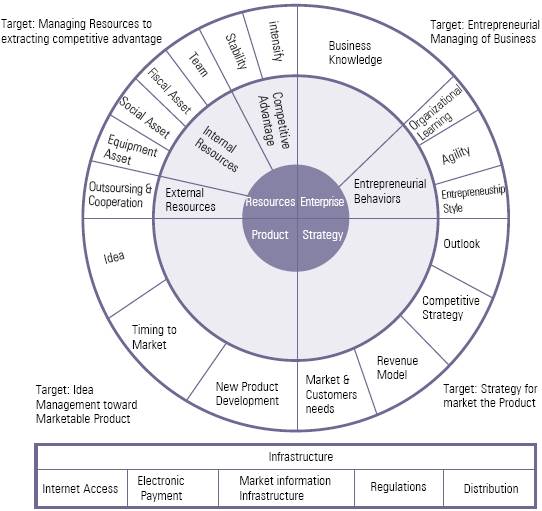
Source: Khajeheian, Datis. (2013). New venture creation in social media platform; Towards a framework for media entrepreneurship. In Handbook of social media management (pp. 125-142). Springer
Figure 1: The framework of media entrepreneurial in social media context (Khajeheian, 2013)
To model the social media entrepreneurship, the authors uses four controllable categories as independent variables, and infrastructure category as intermediate variable. Figure 2 depicts the conceptual model. The research hypotheses are developed as following:
H1: Strategy positively effects on Infrastructure.
H2: Product positively effects on Infrastructure.
H3: Resources positively effects on Infrastructure.
H4: Corporate positively effects on Infrastructure.
H5: Infrastructure positively effects on Entrepreneurial action.
METHODOLOGY
The survey is a flexible research approach used to investigate a wide range of topics (Mathers, Fox, & Hunn, 2007). The present research is a survey research. according to Glasow (2005), in survey research, independent and dependent variables are determined in the study and before the survey, a model is designed to determine the relationships between variables by the researcher.
Sampling
The research population consisted of students and graduates of entrepreneurship and media of Iranian universities. The reason for choosing this statistical community was their close relationship with the subject of research as well as their identification as potential and actual entrepreneurs. The sample number plays an important role in the estimation and interpretation of the structural equation modeling results. Although a small sample is not recommended, but even with 50 samples, it is possible to conclude, but it is recommended that the sample size be 100 (Share Pour 2001), so in this study, considering this consideration, 305 individuals as samples Research was selected. Overall, the statistics of the participants in this study were summarized in Table 1. As you can see, the greatest contributors to this study were men. Undergraduate also contributed 38.2% more than others. Meanwhile, between the ages of 18 and 22, 37.3% were the most contributing. Of the surveyed individuals, 77.7% stated their entrepreneurship intention, indicating that the right partners were selected.
Data Collection
Often employ the questionnaire as a tool for data collection in surveys (Mathers, Fox, & Hunn, 2007). In this study, the questionnaire was used to collect data.The distributed questionnaire was designed via researcher based on the model of Khajehian (2013) and the questionnaire was shared with people through online social media. Questionnaire items are rated with 5 option Likert scale (5 = Extremely and 1 = Very low). The researchers tried to make this questionnaire understandable for everyone, as a questionnaire will be ineffective if it is not designed in a manner easily understood.
Reliability and validity
In the first step, assess the measurement model was done.The reliability of questionnaire evaluated by Cronbach's alpha, Dillon-Goldstein's rho and check the first and second eigenvalue of the indicators' correlation matrix (Table 2). Some researchers suggest 0.7 and above as the favourable point for Cronbach's alpha (Ebrahimi et al., 2018a; Khajeheian and Ebrahimi, 2020) and DG rho (Sanchez, 2013; Hair et al., 2014; Ebrahimi et al., 2019). As the value of these coeftcients is higher than 0.7, the reliability of research means is confirmed. The first eigenvalue should be much more larger than 1 whereas the second eigenvalue should be smaller than 1 (Sanchez, 2013: 57). Accordingly, according to Table 1, the reliability of the research can be confirmed. Also, the convergent validity method was used to determine validity. According to Henseler et al. (2015) the measurement models, according to outer loadings and the AVE index. In order to examine the convergent validity, due reflective measurement model, the values of AVE (Block Communality) have been investigated. Some researchers have pointed out that a higher value of 0.5 indicates the validity of convergence models (Hair et al., 2014; Ebrahimi & Mirbargkar, 2017; Ebrahimi et al., 2018b). As shown in Table 1, the AVE index for the five research variables is higher than 0.5, so we can say that the convergence models is validity. The researchers did not linger on the AVE index for validation, and the convergent validity of the model was examined with respect to outer loadings. Since some researchers consider the value of over 0.4) for outer loadings to be a convergence validity (Hair et al., 2006; Hair et.al, 2014; Ebrahimi et al., 2017), according to the data in Table 1, the validity of the measurement model is confirmed.
Table 2: Measurement models and measures
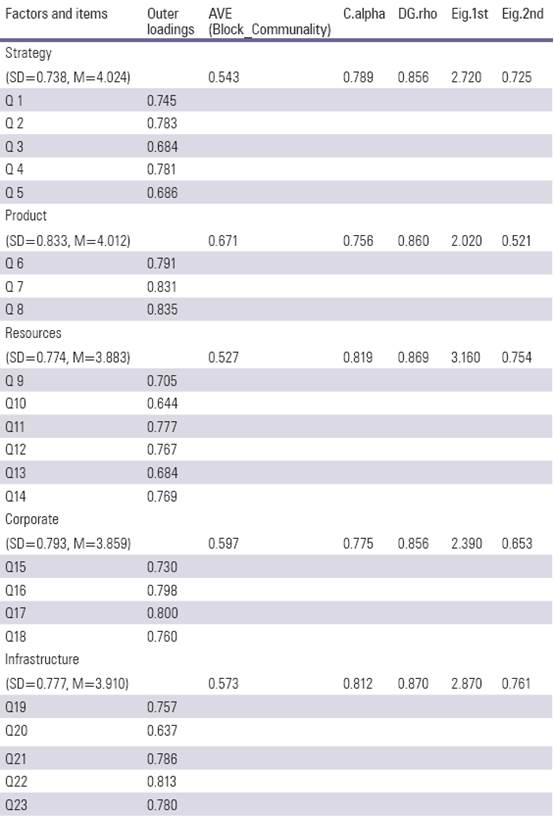
Note: C.alpha, Cronbach’s alpha; DG.rho, Dillon-Goldstein’s rho; eig.1st, first eigen value; eig.2nd, second eigen value; AVE, average of variance extracted; SD, Standard deviation; M, Mean.
Discriminant Validity was assessed at the construct level by HTMT, as it has been shown in Table 3 Values less than 0.9 are considered favorable for this index (Henseler et al, 2015).
ANALYSIS AND FINDINGS
After confirm the reflective measurement models in the first step, in the second step, using the SEM approach with the help of the software packages Plspm and Matrixpls in R software to evaluate the structural model and test the hypotheses. The main reason for using this approach is, firstly, the focus of the study on the prediction of the relationship between independent variables and the dependent variable, and secondly, the model presented in this study was designed exploratory with a previous study of previous research. Software output is calculated after the conceptual model of the research (Figure 3).
The structural model test was performed based on the Inner model. R2 indicates the amount of variance in the endogenous latent variable explained by its independent latent variables. The value of R2 is presented only for the intrinsic variables of the model and its exogenous structures are equal to zero. The greater the R2 value of the intrinsic structures of the model, the better the fit of the model. As shown in Table 4, the coeftcient of R2 for the Infrastructure variable is equal to 61.4 and is equal to 79.7 for the entrepreneurial action variable. Moreover, “Mean_Redundancy” is the amount of variance in an endogenous construct explained by its independent latent variables. In other words, it reflects the ability of a set of independent latent variables to explain variation in the dependent latent variable. High redundancy means high ability to predict (Sanchez, 2013: 68). GoF is an indicator used for general fitting that controls both measurement and structural models. GoF can be used a global criterion that helps us to evaluate the performance of the model in both the inner and the outer models. The higher value of GoF is better (Sanchez, 2013: 80) and in this research the value of GoF is 0.600 and its acceptable good.
In order to test the research hypotheses, direct effects were evaluated. According to the results of Table 5, it can be stated that all research hypotheses have been supported. Actually the bootstrap confidence interval (95%) provided by the percentiles 0.025 and 0.975. This is especially important for the path coeftcients. As you can see from the table (5), bootstrap intervals for the path coeftcients of hypothesis do not contain the zero. Hence we say that these coeftcients are significant at a 5% confidence level.
In the final part of this study, the accuracy of the model was examined and the importance of its factors was determined. By focusing on the Multilayer Perceptron (MLP) Artificial Neural Network (ANN), design items and accuracy were 99.6% complete in model analysis. Also, in line with SEM results, relationships have been evaluated as Synaptic weight estimation, which tracks positively to the ultimate target of entrepreneurial action.
Also, with precision in the MLP-ANN output, we find that the resource variable has the highest importance in the proposed model. Also, the strategy variable is then of great importance. Of course, it is important to note that all the predictors have a positive effect and, in their own place, have an important role in explaining the entrepreneurial action (fig. 5 ).
DISCUSSION
The study of media entrepreneurship has grown in recent years, and various studies have been done in this regard (Hoag & Compaine, 2006; Hoag, 2008; Achtenhagen, 2008; Goyanes, 2015; Girişimciliği, 2018; Achtenhagen, 2017; Tokbaeva,2019; Khajeheian, 2019; Girija, 2019; Hossain, 2019) So that “the practice of media management is becoming entrepreneurial” (Will, Brüntje & Gossel, 2016). The aim of this research was to model media entrepreneurship in social media platforms. Entrepreneurship in media provides policy strategies for promoting new entry and more independent media voices (Hoag, 2008). Findings show that fewer than 10 percent of sample of this study, who are 305 students from the fields of entrepreneurship, media management and business, are not intended to do an entrepreneurial action, and 77 percent of them are willing to involve in entrepreneurial activities. Considering the age of sample, findings confirm Zaheer et al (2018) that attention to media entrepreneurship has a positive relationship with education level and their intention to earn income from social media. They also confirm Tsourvakas and Riskos (2018) that entrepreneurial orientation in the students of journalism has been increased. On the other side, findings of this article contradict with Goyanes (2015), that discussed students of communication in Spain lack entrepreneurial orientation, and therefore it is predictable that they prefer employment in traditional media over entrepreneurship and self-employment. Thus, based on findings of the current research, it can be concluded that Iranian students prefer entrepreneurial actions more than being employed in public or private media organizations. Two major phases conducted in this research. First was assessment of model based on the research framework and test of hypotheses. Second phase was to importance of items in research model.. Five hypotheses tested and confirmed. Based on the model, infrastructure ranked as the strongest variable of research in predicting entrepreneurial action in social media by 0.892 and then accordingly, enterprise, product, resource and strategy are the most effective variables. On the other hand, accordingly, resources, strategy, infrastructure, enterprise and product are the most important variables in entrepreneurial action in social media platforms. It shows resources are the most important factor in media entrepreneurship, emphasizing Alvarez and Busenitz (2001) theory of resource based entrepreneurship. Ireland et.al. (2009) considers strategic management of resources essential to increase entrepreneurial actions. Resource classification systems are provided in a variety of ways, but Chan-Olmsted (2006) considers resources knowledge-based and property-based. Khajeheian (2013) in self framwork argues that resources include competitive advantage, internal resources and external resources; The competitive advantage include of competitive stability and intensify, internal resources include the team, fiscal asset, equipment asset and social capital, and the external sources include of cooperation and outsourcing. Though the classification is different bur For example equipment asset is property-based resource but team is knowledge- based which Chan-Olmsted points to. Importance of this variable shows that a media entrepreneur needs to identify the competitive advantage and how to use internal and external resources to exploit this.
Equipment and fiscal asset as part of domestic resources It has recently been claimed that the digital revolution and disruptive technologies has minimized the need for equipment and fiscal asset (Kong 2008; Khajeheian, Friedrichsen & Mödinger, 2018). Despite the minimal need for financial resources and equipment, social capital as part of the internal resources is a maximum component because “social capital enhances entrepreneurship” (Dana & Light, 2012) and it is an important factor in success of entrepreneurs and Media businesses (Casson & Giusta, 2007; Tsourvakas & Riskos, 2018). The importance of social capital is such that some researchers consider it to be effective in internationalizing companies (Gonzalez-Perez, Velez-Ocampo & Herrera-Cano, 2018). Also, The social network of an entrepreneur as his social capital can be helpful in various phases of business, including the identification of ideas, employment, product distribution, increasing customers, marketing, etc (Tajeddin, Emami & Rastgar, 2018).
The team's and human resources impact on entrepreneurship has also been seen in research; team trends have an impact on entrepreneurial orientation and entrepreneurial action (Makhdoom, Li & Asim, 2019). In media organizations, group productivity is more important than performing individual tasks (Sylvie et al., 2009) and The behavior of team members has been seen as a factor affecting media companies (Dal Zotto & Kranenburg, 2008). "core competitiveness of a company significantly depends on the strategic allocation of human resources and the related policies" (Huang, Huang & Tzeng, 2016) so it can be inferred that the team's value as agents for discovering and creating opportunities it's a lot.
Brown et al (2001) emphasize on the control of resources and argue that outsourcing allows entrepreneurs to act flexible and agile and to act successfully; This indicates the importance of outsourcing and cooperation. One of the respondents of this research is a media entrepreneur that used telegram social platform to exchange research materials, but in spite of identification of a niche market, because of lack of suftcient staff to response the demand, failed. It confirms Girişimciliği (2018) that argues an entrepreneur needs to use external resources. All in all, resources are yet a fundamental need for entrepreneurial action. Strategy has introduced as the second important variable in social media entrepreneurship. Albarran believes "Strategic management is concerned with developing the tools and techniques to analyze industries and competitors and developing strategies to gain competitive advantage." According Daidj (2018) A Strategic Approach at Two Levels include External and Internal. What is discussed in strategy is the need customers, revenue model, competitive model and outlook refer than at by Picard (2011) in the form of media economics concepts and by kung (2008) in the framework of strategic media management concepts and Includes both levels. The Outlook is as a part of the strategy one and it has been named a dignified key force on the media company (Dal Zatto & Kranenburg, 2008). Also, a media entrepreneur must for survival, looking for customer retention, build relationships with them and keep them loyal (Gladysz, Khajeheian & Lashkari, 2018) because In the age of disruptive technologies, it's harder to keep a customer harder (Tamaddoni et al, 2017). In the case of the revenue model, According Tsourvakas & Riskos (2018) shows that For the electronic media business, a multiple income resource strategy is not necessary for success, so for media entrepreneurial action on the social network, it can be said that having a primary revenue model is suftcient.”A firm can develop a revenue model based on subscription costs and fees (customer side), advertising (often used in media and entertainment), sponsoring revenues, revenue sharing (with other firms), and commissions and transaction cuts from provided services, and by simply selling a product” (Daidj, 2018). In recent decades the concept of strategy is intertwined in entrepreneurship, and on the same basis strategic media entrepreneurship has been attracted new research interest (Hasenpusch & Baumann, 2017; Horst & Murschetz, 2019).
Strategic media entrepreneurship is “coexistence or combination of opportunity- seeking and advantage-seeking behaviors” (Horst & Murschetz, 2019). There are two points of view about the opportunity; the perspective of the creation of the opportunity and the perspective of the discovery of opportunity (Will, Brüntje & Gossel, 2016). strategic media entrepreneurship seems to seek to discover the opportunity As Hindle and Klyver (2007) sees the opportunity search activity as the first phase of entrepreneurship. According Horst and Murschetz (2019) strategic media entrepreneurship the company has a better performance; Media strategic entrepreneurship seems to require "dynamic capabilities" management because Oliver (2016) claims "dynamic capabilities" as the most complex component of media company compliance with the highly complex environment of corporate performance. Dynamic capabilities management leads to a strategic renewal of the media as a process in entrepreneurship. Hang (2018) say “strategic renewal leads only to the reconfiguration of existing business within a corporate setting”. Strategic renewal is usually based on the identification of new opportunities, and much of it is based on imitative innovation; Khajeheian (2013) referred to imitative innovation as a way of success of entrepreneurial media action in Iran. Although the importance of strategy is at a very short distance after resources, without strategy, entrepreneurship is not possible.
Infrastructures ranked as the third variable. Based on the framework, legal infrastructures, internet access, payment, market information, and distribution are the main factors of infrastructure. Goyanes (2015) argues that entrepreneurial perception from the infrastructures may lead to increased intention to entrepreneurship and Turker and Sonmez (2009) emphasize on the importance of infrastructure on entrepreneurship intention. The Internet is recognized as an essential infrastructure for the media's entrepreneurial action on social networks; Kung (2008) say Internet and digitization are an opportunity for media companies to move to new areas and Berthod, Huyskens and Loebbecke (2007) talk about Internet entrepreneurship. Hajmohammadi (2018) stress that internet is a source for Iranian entrepreneurs to offer new services, such as internet taxies, delivering services, e-payments and many different services. In fact, with the growth of the Internet and access to social networks, digital entrepreneurship has been intensified (Nambisan, 2017; Labafi, 2017). According to Sylvie et.al. (2009) Laws and regulations are highly complex in the media industry; media entrepreneurs claim that freedom of business activity is limited by rules and regulations (Rebouças, 2018) so many of researchers stress on the importance of policy for fostering of media entrepreneurship and discuss that government must reduce regulations to facilitate entrepreneurship (Rebouças, 2018; Safari, 2018; Khajeheian, 2014, 2016; Doyle, 2013). The market information system was referred to as part of the infrastructure; market information is both informally and informally gathered. Some companies now operate in the field of market intelligence collection and sell it to applicants, which we call the formal collection of market information. But another part of collecting market information can be done through social media networks because The social media are inexpensive sources and of market intelligence and source customer’s voice (Safari, 2018).
Enterprise and product placed at the last ranks, with a considerable distance with strategy and resources. The Enterprise includes business knowledge, agility, organizational learning, and entrepreneurial style. Some researchers emphasize that business knowledge effects on the success of business (De Clercq & Arenius, 2006; Fernandes et.al, 2017; Labafi et al, 2018). The knowledge structure provides an opportunity to identify and design value (Emami & Naderi, 2018).Also, the product includes the strength of the idea, the timing of the product presentation and the development of product skills. Albarran (2006) says the product is the most important thing to distinguish media from other companies. Media products usually include nonmaterial element and a material element And since they are considered talent goods (Medina, Sánchez-Tabernero &Arrese, 2016) without strong ideas are taken into consideration. Tsourvakas & Riskos (2018) argues that idea is the cornerstone of entrepreneurship and must be considered as a critical success factor.
Kong (2008) writes: The first patterns of media success indicated the increase in the production of products, because the basic assumption of the system was that "a good idea is finally taken into consideration." Although this success system is now outdated, it shows that a good idea is a prerequisite for success, and successful entrepreneurial action needs a good idea (Emami & Khajeheian, 2019). According to Huyskens & Loebbecke (2007) Consider the idea of product and service as a driver of entrepreneurial success. Although the idea is referred to as an opportunity and is referred to as the first step in the creation of a business (Salamzadeh & Kirby, 2017) , one can actually see the idea in the heart of opportunities. Finding an idea is a product development issue (Yousefikhah, 2017; Moradi-abadi et al, 2017). An entrepreneur who does not dominate product development skills may fail, as product development involves a process that begins with identifying needs and continues to grow in satisfactory sales. That's why it is emphasized that product development skills are taught for entrepreneurship (Silva, Henriques & Carvalho, 2009). All at all, It can be concluded that access to social media and low-risk possibility of offering a product or service based on social media is the reason to rank these two important factor lower than former variables.
CONCLUSION AND SUGGESTIONS
This research contributes in development of media entrepreneurship by modeling of this concept for the first time (as far as a thorough search of databases shows). The authors hope that this model will be used by entrepreneurs as well as policymakers to develop media entrepreneurship (Khajeheian, 2016). It suggests that policy makers must pay enough attention to infrastructures and to invest suftciently on internet, payments, and communication infrastructures and also to reduce the bureaucracy and regulations. It also concluded that entrepreneurs must balance their investment of all four categories of media entrepreneurship factors and to not overlook one in cost of others.
The authors suggest the future researchers to conduct new researches to develop measures for evaluating the success of media entrepreneurship in each of these classes. Also they suggest the researchers to work on development of more advance models that cover all 23 factors of the framework and to provide more detailed explanation of how these factors impact successful media entrepreneurship.
Another suggestion is to conduct a new research to re-explore the framework of Khajeheian (2013) and to understand if new trends and disruptive technologies have changed some factors of the framework.













